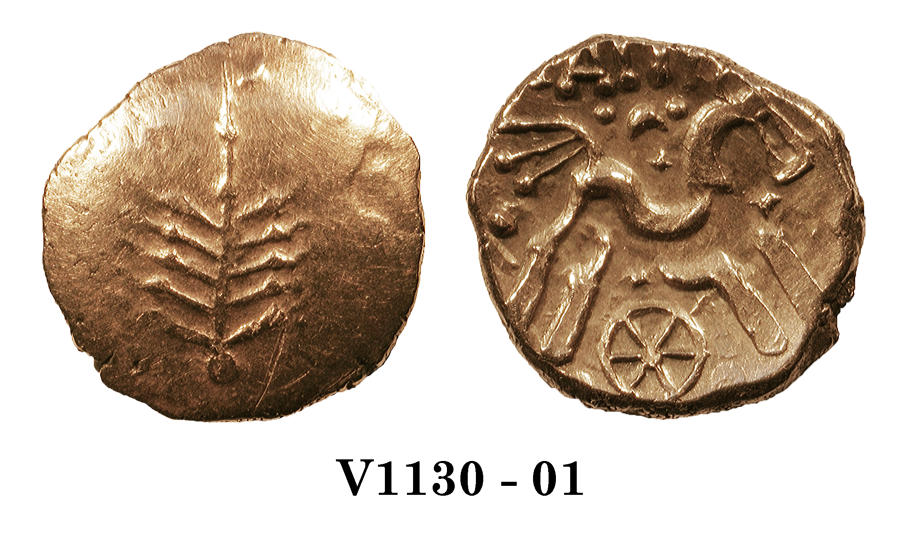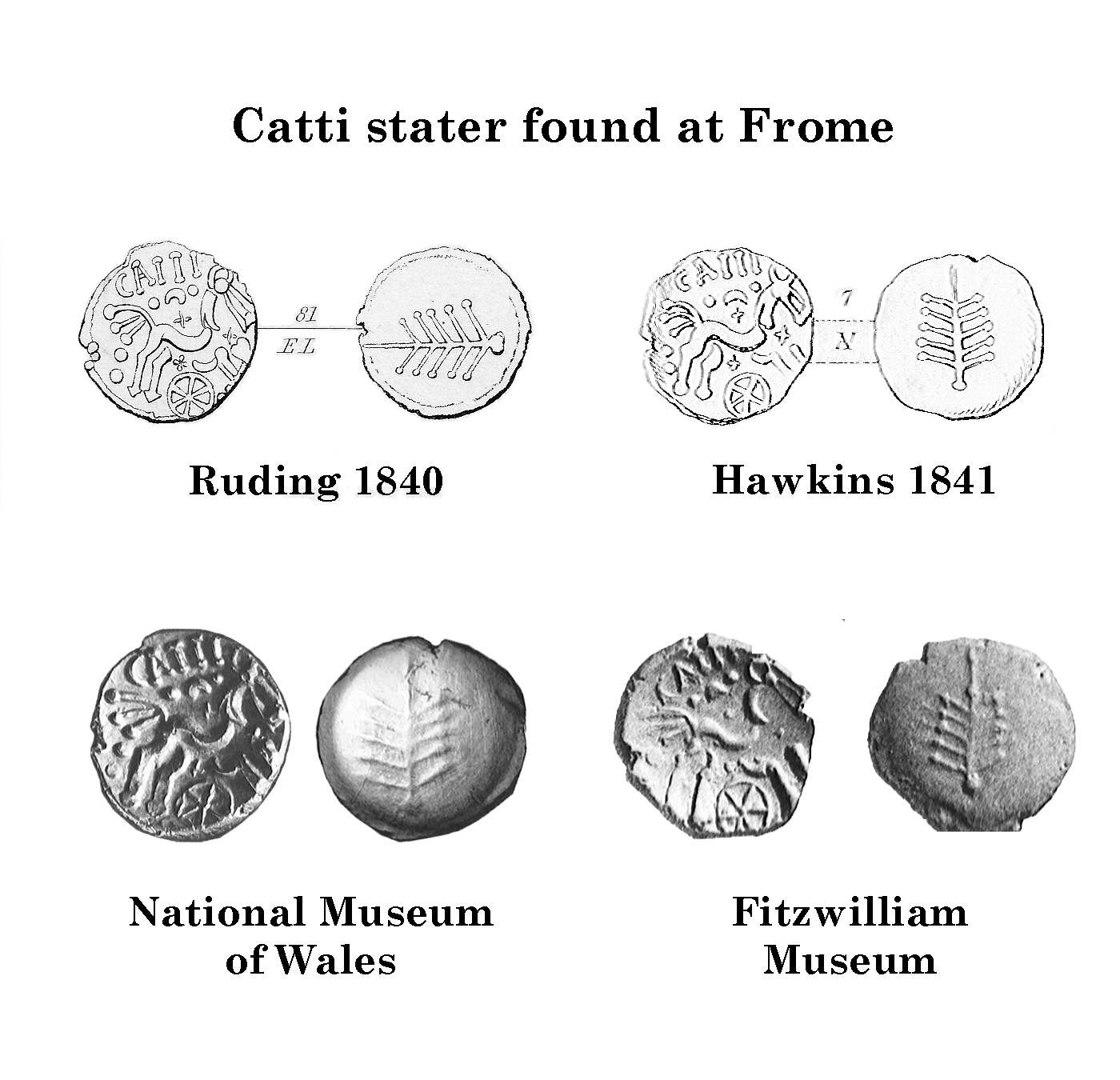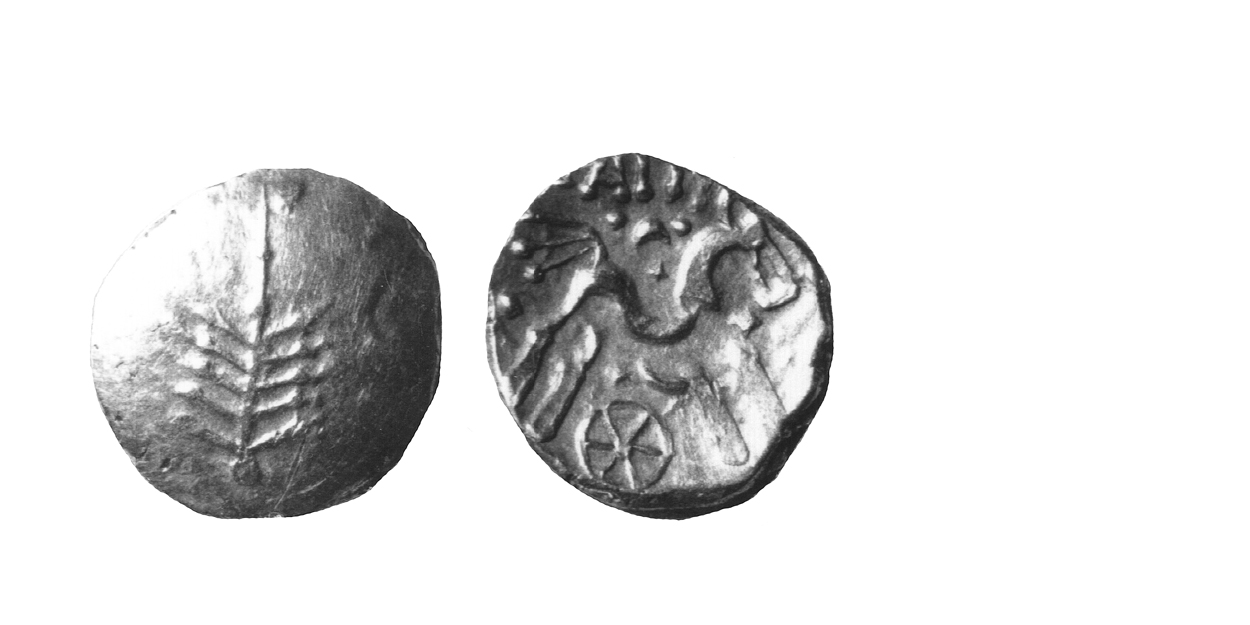
Numismatic Articles
Van Arsdell 2015h (Info)
Catti and Nunney
By Robert D. Van Arsdell
This article suggests the current locations of two CATTI staters, both lost for more than 150 years. (info about CATTI staters)
The fact they’ve been lost is not unusual. Many Celtic coins found in the 19th century cannot be identified today. Written records can be sketchy and the details of contemporary illustrations unreliable.
However, it’s the job of numismatists to try and re-establish coin provenances whenever possible. The work is complicated and uncertain, and it seldom yields satisfactory results. Occasionally, though, the records are good enough to reach tentative conclusions. At this point, many conclude it’s too risky to publish anything, and their thoughts are lost forever. This is a pity, because speculations can prompt others to research, and eventually the truth may be revealed.
Two of the five CATTI staters found before 1864 are missing today. Allen probably tried to locate them in the 1950s, but looking into the early records may have concluded the job was impossible (info). However, there is reason to believe that the two lost coins might be identified and their provenances re-established. The task is to identify the three known coins and then try to locate the missing pair.
The Finds
The first coin was found at Frome, Somerset in 1836. It immediately went into James Dodsley Cuff’s collection and was auctioned off in 1854 (info). The coin then disappears from the records (info). There is no weight recorded for the coin, but three published illustrations agree reasonably well (info).
The second coin was purchased by the British Museum in 1840 from a dealer named Cureton (presumably Henry Osborne Cureton). The coin has no recorded findspot, but is still in the BM and weighs 5.34 gms (info).
The third coin was found at Chepstow. It was purchased by the BM in 1851, and weighs 5.36 gms (info).
In 1860, Evans reported that two examples were found in the Nunney Hoard (one of them weighing 85 ½ grains) (info). The other coin, weighing 5.37 gms, went to the BM in 1919, the first coin is missing (info).
In 1864, Evans listed four of the five CATTI staters (the Cureton coin is not mentioned) and gives four weights – 83, 81, 83 ¼ and 85 ½ grains). These correspond to 5.38, 5.24, 5.39 and 5.54 gms (info).
Taking all the records together (and allowing for minor weight discrepancies):
- The 5.34 gm Cureton coin is in the BM
- The 83 grain coin is the Chepstow find in the BM
- The 83 ¼ grain coin is the Nunney Hoard coin in the BM
- The 85 ½ grain coin is the other Nunney Hoard coin, now missing
- The 81 grain coin (by a process of elimination) is the Frome coin from the Cuff collection, now missing
Thus we are looking for missing coins that weigh 5.24 and 5.54 gms, respectively.
The Cuff collection coin found at Frome

Of the two missing coins, the Frome example is shown in three contemporary illustrations. Two of these are reproduced above, along with two coins that possibly match the illustrations.
The National Museum of Wales coin does have the flan cracks in the right places, and matches the illustrations far better of the two. It reportedly weighs 5.329 gms, so is 0.09 gms heavier than the weight given in Evans (info).
The coin from the Fitzwilliam Museum does not have the flan cracks in the right places. But it does weigh 81.2 grains (5.26 gms), so the weight is about right (info). The Fitzwilliam coin cannot be traced much before 1939, though unpublished records may exist.
If Allen had gotten this far with his analyses in the 1950s, no one would have faulted him for dropping the matter altogether. However, if one had to make a choice between a weight match and a match to published illustrations, one would be inclined to trust the image match here.
As a speculation, I suggest that the coin in the National Museum of Wales, in the absence of other information, may be the missing coin from the Cuff collection found at Frome in 1836.
Perhaps this suggestion will prompt other workers to uncover more information and settle the matter for all time. For example, it might be worth re-weighing the NMW coin to see if the record is correct. The weight is handwritten on the Celtic Coin Index card as 5.329 gms. If the record has two transposed numbers and is actually 5.239 gms, then the issue might be resolved.
It should be mentioned that Evans published three more coins in 1890 (info). One, from Newnham Bridge is in the Ashmolean Museum. The other two are missing. One of these was found in 1864 at Camborne, Cornwall, the other in Bellator Tor about 1870. None of these coins should be confused with the Frome coin, having been found much too late (unless there is some gross error in the 1864-1870 records).
The Second Nunney Hoard coin
The second coin from the Nunney Hoard of 1860 is perhaps even more difficult to identify. There are no illustrations of it, and we only have the weight to go on.
Fortunately, the reported weight of 5.54 gms (85 ½ grains) is that of the heaviest CATTI stater ever found. Almost all of the CATTI staters reported to the Celtic Coin Index weigh less than 5.48 gms (info).
The heaviest CATTI stater known is the coin from the 1909 Rashleigh sale (info). It weighs 5.5403 gms.
Rashleigh bought this stater before 1900 (his collection passed to his son in that year). He probably acquired it much earlier. De Jersey notes the competition for coins between John Evans and the collector-dealer Roderick Murchison. Correspondence between Rashleigh and Evans mention Murchison’s purchases and a letter of J. W. Singer of Frome to Evans discussed the competition to buy coins from the Nunney Hoard specifically (info). Rashleigh may have bought the CATTI stater shortly after the Nunney Hoard was found, possibly with an assist from Murchison. However this is speculative. Unless records of Rashleigh’s purchases can be uncovered, all we know is that the coin was bought before 1900.
There is just enough evidence to suggest that the Rashleigh example may be the best candidate for the missing coin from the Nunney Hoard. The stater illustrated at the head of this article is that coin (info).
I don’t expect that my suggestions about the two missing coins will be initially accepted, for the issues involved are far from resolved. I do hope, however, that this article spurs researchers with access to unpublished records to suggest provenances for “lost” coins. The work often requires favouring one class of evidence over another depending on the specifics of the case. Be forewarned: you will find, as Sir Thomas Browne put it in the introduction to his Pseudodoxia Epidemica, “And therefore surely in this work attempts will exceed performances”.
End

